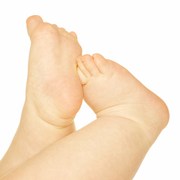 Vitaliy Pakhnyushchyy/PhotoSpin
Vitaliy Pakhnyushchyy/PhotoSpin
According to the American Pregnancy Association, "[b]reech births occur in approximately 1 out of 25 full-term births.” The likelihood of a breech birth increases with preterm babies as they may be born before they’ve had a chance to turn.
Most babies are in a breech position (that is, their head is not down) until the head becomes heavy enough and the baby turns, usually between 5 and 7 months of age.
Most babies are in a transverse lie or sideways position until 24-26 weeks. By 30-32 weeks, most babies will be head down. (2) Some babies don’t turn until term (37 and 42 weeks).
Contributing Factors to a Breech
There are several theories as to why some babies never turn, and they center around the mother’s natural body shape.
Every woman's shape is uniquely different. Pelvic alignment and the length and strength of the ligaments in the area all dictate the shape and how symmetrical the uterus is. (2)
1) Two-roomed uterus
Some women have a center membrane (septum) that creates two “rooms” in the uterus instead of the uterus being a single room. With the baby growing in a smaller space, there is no room for him/her to turn.
2) Bicornate uterus
Some women’s uteruses are heart shaped at the top or bicornate, making a breech birth more likely.
3) Pelvic torsion (twist)
Sometimes the ligaments supporting the womb are pulled off balance because of a twist or torsion in the pelvic joints. This means the head won’t fit in the down position.
4) Amount of amniotic fluid –
Particularly if there is not enough amniotic fluid, there is not enough space for the baby to turn head down.
5) Placenta
The position of the placenta may get in the way of a head down position.
6) Big baby / small baby
The bigger the baby, the less room there is for the baby to turn. Smaller than average babies which usually occur in multiple births, may also present in a breech position since there is less room for him/her to move around.
7) Uterine fibroids or cysts These change the internal shape, size, and space of the uterus, and can prevent a baby from being able to turn.
Dissenting opinions of “normal”
Many obstetricians in the United States hold that a breech presentation for a baby is abnormal. However, in Europe and Australia the view is changing.
Many are also changing the traditionally held view that breech babies can only be born via cesarean section. In some cases a vaginal delivery is possible, particularly when done when in a kneeling position, as opposed to on the back or partially sitting positions ... but that’s for another article.
Sources:
1) Breech Births. American Pregnancy Association. Web. Oct 16, 2012.
http://www.americanpregnancy.org/labornbirth/breechpresentation.html
2) About Breech. SpinningBabies.com. Web. Oct 16,2012.
http://spinningbabies.com/baby-positions/breech-bottoms-up/about-breech
3) A breech baby at the end of pregnancy: Information for you. Royal College of Obstetricians and Gynaecologists (UK). Web, Oct 16, 2012.
http://www.rcog.org.uk/files/rcog-corp/A%20Breech%20Baby%20at%20the%20end%20of%20Pregnancy.pdf
4)Breech a variation of normal. Homebirth: A Midwife Mutiny. Oct 16, 2012.
http://www.homebirth.net.au/2008/03/breech-variation-of-normal.html (Australian article)
5)Canada does a 180. StandandDeliver. Web. Oct 16, 2012.
http://rixarixa.blogspot.ca/2009/06/canada-does-180.html (which is Canadian and quotes the Society of Obstetricians & Gynecologists of Canada (SOGC) in a Globe&Mail article.
Reviewed October 17, 2012
by Michele Blacksberg RN
Edited by Jody Smith





Add a CommentComments
There are no comments yet. Be the first one and get the conversation started!